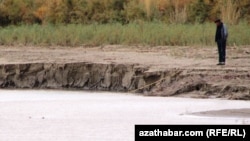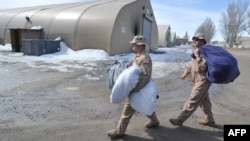
Long-awaited help has been promised for the Turkmen of the Qarqeen area in northern Afghanistan and RFE/RL’s Turkmen Service, Azatlyk, can claim some credit for that.
Azatlyk recently did extensive reporting on the plight of Turkmen on the Afghan side of the border, their problems with militants, with Turkmenistan’s border guards, and security forces, and with the river that divides the Turkmen people.
The appeals from the people of Qarqeen district in Jowzjan Province had previously gone unheeded, especially those being made to their neighbors -- the ethnic Turkmen of Turkmenistan.
The governor of Afghanistan’s northern Jowzjan Province, which borders Turkmenistan, contacted Azatlyk to say he had been in touch with officials from Turkmenistan.
Speaking to Azatlyk by telephone on April 3, Governor Baymyrat Goyunly said Turkmenistan’s consul-general contacted him a few days earlier. The official told the governor that a team from Turkmenistan would be sent to assess how best to solve one of Qarqeen’s biggest problems -- the migrating river.
The flow of that river, the Amu-Darya, has been eating away the bank on the Afghan side of the border for decades, extending Turkmenistan’s territory at the expense of the people in the Qarqeen district.
Qarqeen’s Turkmen told Azatlyk in February and March that they hoped Turkmenistan would renew help to reinforce the Afghan bank of the Amu-Darya and stop the loss of precious Afghan agricultural land.
Turkmenistan suspended such help several years ago and the results have been disastrous for Qarqeen’s residents, many of whom have fled farther south into the inhospitable desert.
Goyunly said he requested the consul-general to send the team from Turkmenistan to Qarqeen and the Khamyab district to the west, where the situation is the same, after the April 5 presidential election.
Azatlyk’s correspondent in Jowzjan reported another positive development.
The "mistreated" Afghan Turkmen also complained just last month to Azatlyk that they were in danger of being beaten, detained, or imprisoned by Turkmenistan’s border guards and security forces if they went to the islands that have emerged in the Amu-Darya as the river has shifted. The Afghan Turkmen wish to graze their cattle on these islands, which they say was once part of Afghanistan and where their villages were located.
Azatlyk’s Jowzjan correspondent reported that Turkmenistan’s border guards have recently given Afghan Turkmen permission to graze their cattle on the islands with the understanding they cannot set foot on Turkmenistan’s bank of the Amu-Darya.
This sudden change in the situation along the Turkmen-Afghan border came after Afghan President Hamid Karzai hosted a Norouz celebration in Kabul on March 26.
Several regional leaders attended. Turkmenistan was represented by longtime Foreign Minister Rashid Meredov. The Afghan Turkmen sent a delegation of 50 elders, including some elders from Qarqeen, to meet with Meredov in Kabul.
Sources who attended the talks told Azatlyk that Meredov promised those Turkmen elders that Turkmenistan would help them construct barriers along the river bank.
Obviously a huge amount of credit for the change in fortune of Qarqeen’s Turkmen goes to these elders who made the long trip to the capital.
But Governor Goyunly said the first phone call he made after speaking with Turkmenistan’s general consul was a latenight conversation with the Azatlyk correspondent who has been instrumental in getting the region’s story out to the world.
And the governor was happy to speak by phone with Azatlyk in Prague a couple of days later to answer some follow-up questions.
And of course, we here at RFE/RL in Prague know some of Turkmenistan’s government officials have been listening to us, and keeping track of what we say, for many years now.* So someone in Ashgabat has undoubtedly heard what Azatlyk has been reporting recently about the ethnic Turkmen in Jowzjan, Faryab, and Baghdis provinces.
Now the wait begins to see if promises become reality. But at least the people in Qarqeen district have hope that their most basic wishes might soon come true.
-- Bruce Pannier with contributions from Muhammad Tahir of RFE/RL’s Turkmen Service
Azatlyk recently did extensive reporting on the plight of Turkmen on the Afghan side of the border, their problems with militants, with Turkmenistan’s border guards, and security forces, and with the river that divides the Turkmen people.
The appeals from the people of Qarqeen district in Jowzjan Province had previously gone unheeded, especially those being made to their neighbors -- the ethnic Turkmen of Turkmenistan.
The governor of Afghanistan’s northern Jowzjan Province, which borders Turkmenistan, contacted Azatlyk to say he had been in touch with officials from Turkmenistan.
Speaking to Azatlyk by telephone on April 3, Governor Baymyrat Goyunly said Turkmenistan’s consul-general contacted him a few days earlier. The official told the governor that a team from Turkmenistan would be sent to assess how best to solve one of Qarqeen’s biggest problems -- the migrating river.
The flow of that river, the Amu-Darya, has been eating away the bank on the Afghan side of the border for decades, extending Turkmenistan’s territory at the expense of the people in the Qarqeen district.
Qarqeen’s Turkmen told Azatlyk in February and March that they hoped Turkmenistan would renew help to reinforce the Afghan bank of the Amu-Darya and stop the loss of precious Afghan agricultural land.
Turkmenistan suspended such help several years ago and the results have been disastrous for Qarqeen’s residents, many of whom have fled farther south into the inhospitable desert.
Goyunly said he requested the consul-general to send the team from Turkmenistan to Qarqeen and the Khamyab district to the west, where the situation is the same, after the April 5 presidential election.
Azatlyk’s correspondent in Jowzjan reported another positive development.
The "mistreated" Afghan Turkmen also complained just last month to Azatlyk that they were in danger of being beaten, detained, or imprisoned by Turkmenistan’s border guards and security forces if they went to the islands that have emerged in the Amu-Darya as the river has shifted. The Afghan Turkmen wish to graze their cattle on these islands, which they say was once part of Afghanistan and where their villages were located.
Azatlyk’s Jowzjan correspondent reported that Turkmenistan’s border guards have recently given Afghan Turkmen permission to graze their cattle on the islands with the understanding they cannot set foot on Turkmenistan’s bank of the Amu-Darya.
This sudden change in the situation along the Turkmen-Afghan border came after Afghan President Hamid Karzai hosted a Norouz celebration in Kabul on March 26.
Several regional leaders attended. Turkmenistan was represented by longtime Foreign Minister Rashid Meredov. The Afghan Turkmen sent a delegation of 50 elders, including some elders from Qarqeen, to meet with Meredov in Kabul.
Sources who attended the talks told Azatlyk that Meredov promised those Turkmen elders that Turkmenistan would help them construct barriers along the river bank.
Obviously a huge amount of credit for the change in fortune of Qarqeen’s Turkmen goes to these elders who made the long trip to the capital.
But Governor Goyunly said the first phone call he made after speaking with Turkmenistan’s general consul was a latenight conversation with the Azatlyk correspondent who has been instrumental in getting the region’s story out to the world.
And the governor was happy to speak by phone with Azatlyk in Prague a couple of days later to answer some follow-up questions.
And of course, we here at RFE/RL in Prague know some of Turkmenistan’s government officials have been listening to us, and keeping track of what we say, for many years now.* So someone in Ashgabat has undoubtedly heard what Azatlyk has been reporting recently about the ethnic Turkmen in Jowzjan, Faryab, and Baghdis provinces.
Now the wait begins to see if promises become reality. But at least the people in Qarqeen district have hope that their most basic wishes might soon come true.
-- Bruce Pannier with contributions from Muhammad Tahir of RFE/RL’s Turkmen Service






